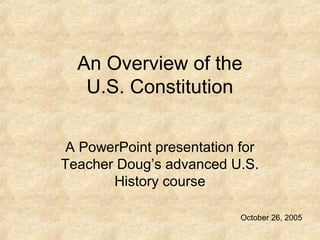
Constitution
- 1. An Overview of the U.S. Constitution A PowerPoint presentation for Teacher Doug’s advanced U.S. History course October 26, 2005
- 2. Contrast: The Articles of Confederation (1781) and the U.S. Constitution (1789) • Structure? • Legislature? • Other branches? • Taxation? • Currency? • Trade? • Power?
- 3. Contrast: Structure Articles of Confederation • Loose alliance of independent states U.S. Constitution • National government representing all Americans
- 4. Contrast: Legislature Articles of Confederation • Unicameral (one- house) law-making body: Congress U.S. Constitution • Bicameral (two- house) law-making body: Congress – Senate (Upper House) – House of Represent- atives (Lower House)
- 5. Contrast: Other Branches Articles of Confederation • No executive or judicial branches U.S. Constitution • Executive branch – President – Cabinet • Judicial branch – Supreme Court – Appellate courts
- 6. Contrast: Taxation Articles of Confederation • Only states can tax U.S. Constitution • Congress also has the power to tax
- 7. Contrast: Currency Articles of Confederation • Only states can coin money U.S. Constitution • Only national government can coin money
- 8. Contrast: Trade Articles of Confederation • No effective regulation of trade between states U.S. Constitution • National government regulates trade between states
- 9. Contrast: Power Articles of Confederation • Most power held by the individual states U.S. Constitution • Most power held by the national government in conjunction with the state governments • Federalism: states subordinate power to central government
- 10. The Constitution in Brief • Article I: Legislative Branch • Article II: Executive Branch • Article III: Judicial Branch • Article IV: State Powers • Article V: Amendments • Article VI: Power of Law • Article VII: Ratification • Amendments (Bill of Rights plus 11-27)
- 11. Article I: Legislative Branch • Senate and the House of Representatives – Representatives: elected for two-year terms • Must be 25 yrs. old, citizen 7 yrs., and live in state • Numbers based on pop.; census every 10 yrs. – Senators: elected for six-year terms • Only 2 senators per state; staggered elections • Must be 30 yrs. old, citizen 9 yrs., and live in state • Vice President = President of the Senate
- 12. Article I: Legislative Branch • Some Notable Powers of Congress – Pay off national debt – Borrow money – Punish counterfeiting – Create laws – Declare war – Raise an army – Maintain national roads
- 13. Article II: Executive Branch • President: Commander in Chief – Must be born in the U.S. or to U.S. parents • At least 35 years old; 14 years resident of the U.S. – Elected to a four-year term • Chosen by the Electoral College – Electors = total number of a state’s representatives plus senators – Most votes = President; Second-most votes = V.P. » Process changed by the 12th Amendment
- 14. Article II: Executive Branch • Powers of the President – Oath: “preserve, protect, and defend the Constitution of the United States” – Grant pardons for offenses against U.S. – Appoint ambassadors – Appoint nominees for the Supreme Court – Appoint temporary Senate vacancies – Deliver annual State of the Union address
- 15. Article III: Judicial Branch • United States Supreme Court – One Chief Justice – How many Associate Justices? • Judicial power extends to all cases – Authority over all government officials – Can declare any act unconstitutional • Trial by jury in all cases - except impeachment - in the state of the crime
- 16. Article IV: State Powers • An attempt to balance federal power with state authority – State records shall be given full faith + credit – State citizens are entitled to certain privileges – Extradition for crimes state to state – Admission of new states – U.S. guarantees a republican form of govt. and protection from invasion and rebellion
- 17. Article V: Amendments • In order to propose an amendment, – 2/3 approval of both Houses of Congress OR – 2/3 approval of state governments is needed • In order to ratify an amendment, – 3/4 approval of both Houses of Congress OR – 3/4 approval of state governments is needed • When was the last time that an amend- ment was ratified? (Hint: #27)
- 18. Article VI: Power of Law • Constitution is the supreme law of the land – Contracts and debts before the Constitution shall be valid under the Constitution – All government officials are bound by an oath of office to support the Constitution – No religious test shall ever be required as a qualification for any office
- 19. Article VII: Ratification • In order to ratify the Constitution, the consent of how many state conventions was necessary? • When the Constitution was ratified on September 17, 1787, how many of the states present supported the idea? – Which state was admitted into the Union first? – What did this signify?
- 20. Amendments • Bill of Rights (1-10) – Why were these ten amendments added to the Constitution in 1791? – Which one of the first ten amendments do you think is the most important? Explain why. • Amendments 11-27 – Which one of these amendments do you think is the most important? Explain why.
- 21. Be prepared for a 25-point quiz in the not-too-distant future about the Constitution.